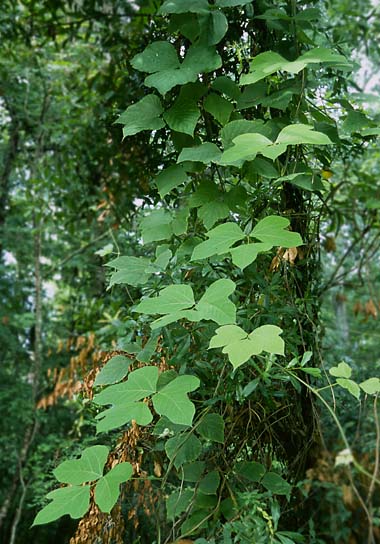Kudzu
Pueraria montana var. lobata
Family: Fabaceae
Natural History

Kudzu vine climbing a tree
Photo credit: Larry Korhnak, University of Florida
Kudzu is an aggressive vine that can grow about one foot per day reaching up to 100 feet long with a stem diameter up to 4 inches thick. It has leaves that are compound with three leaflets that are either entire or lobed. Kudzu produces fragrant purple flowers in late summer and early fall which produce many seeds that are eaten and dispersed by birds and mammals. It has underground rhizomes that can produce up to 30 vines and has a thick tap root that can weigh 400 pounds.
Kudzu can climb into treetops completely covering trees and plants. This growth can completely block sunlight which can eventually kill the plants it covers. Kudzu not only covers vegetation, but it can also engulf buildings, fences, and road signs. Kudzu was first introduced into the United States from East Asia in 1876 as an ornamental plant. In the 1920's to the 1950's, this vine was used for agricultural purposes and planting was encouraged for erosion control. Kudzu now covers an estimated 2 million acres in the southern United States and is listed on the Florida Noxious Weed List and listed as a Category I invasive plant by the Florida Exotic Pest Plant Council (FLEPPC).
Kudzu is native to East Asia and is found throughout the southeastern United States from Florida, west to Texas, north to Oklahoma and Illinois, and east to Massachusetts. It covers approximately 2 million acres in the United States.
In Florida, Kudzu can be found in many different ecosystems such as scrub, sandhill, xeric hammocks, bottomland forests, swamps, and areas that have been disturbed such as roadsides, forest edges, and yards.
Kudzu seeds are eaten and dispersed by birds and mammals.
Kudzu was historically used as an ornamental plant, as forage for livestock, and as erosion control until it was listed as a weedy plant in the 1950's.
